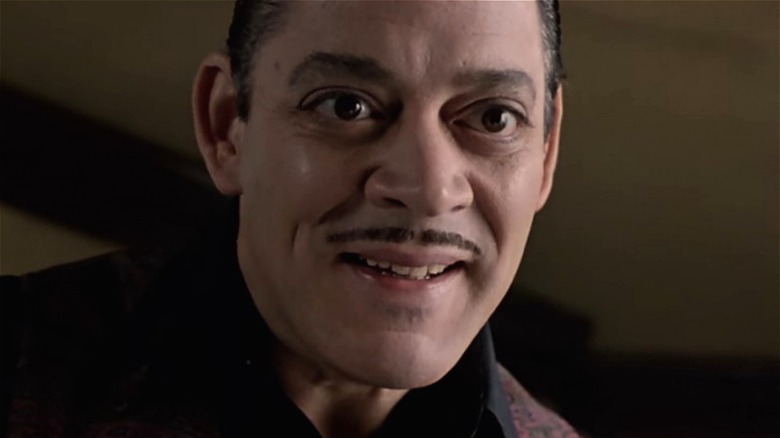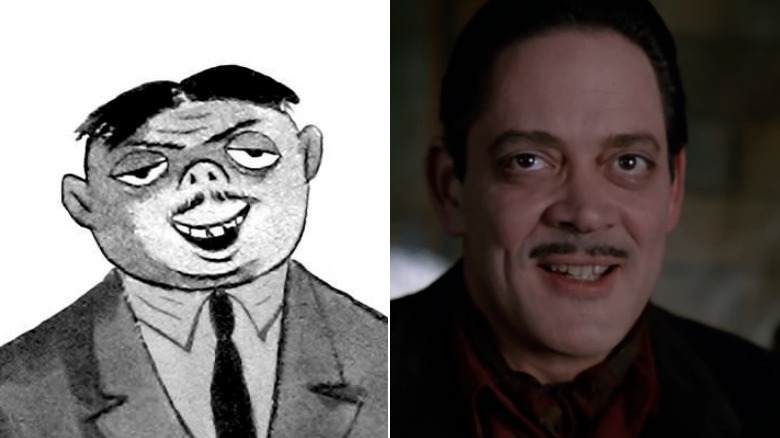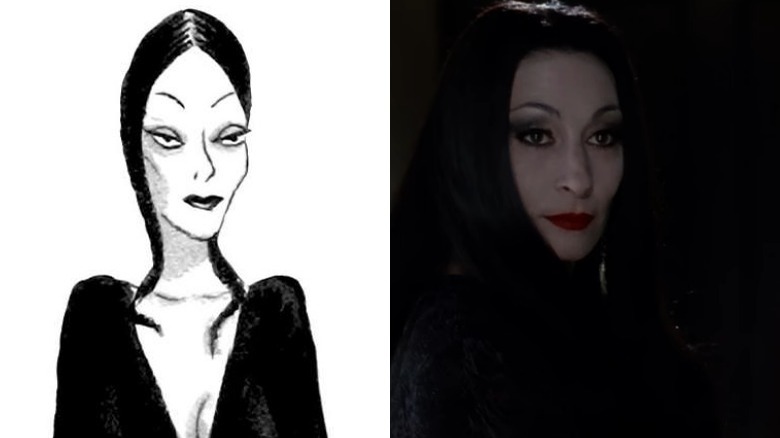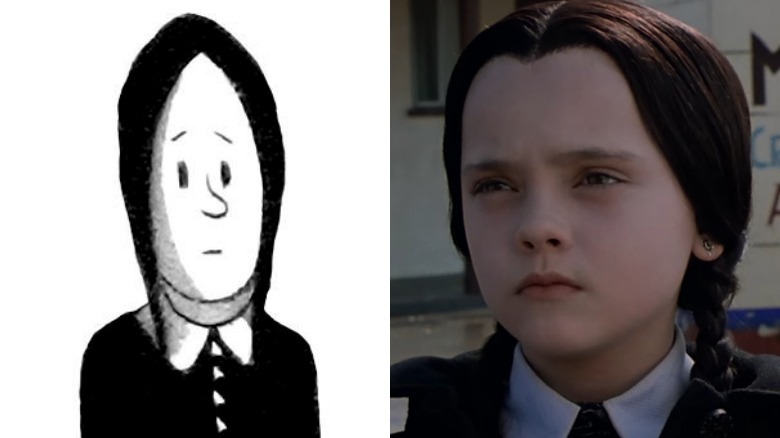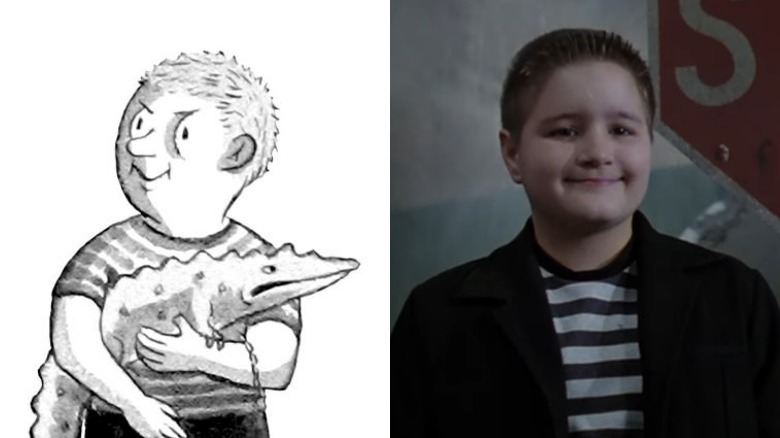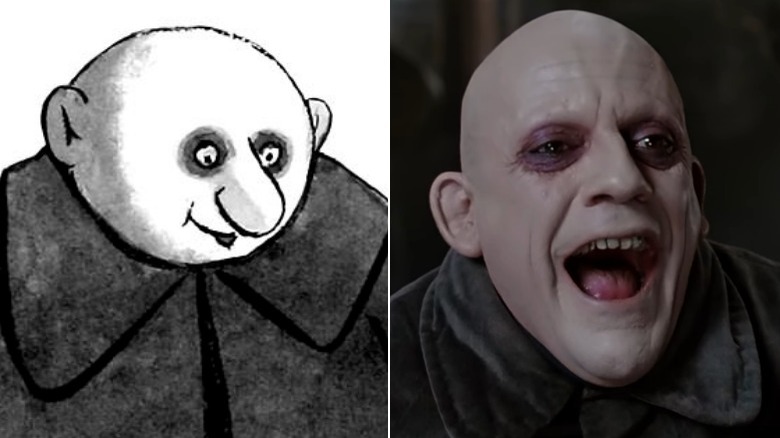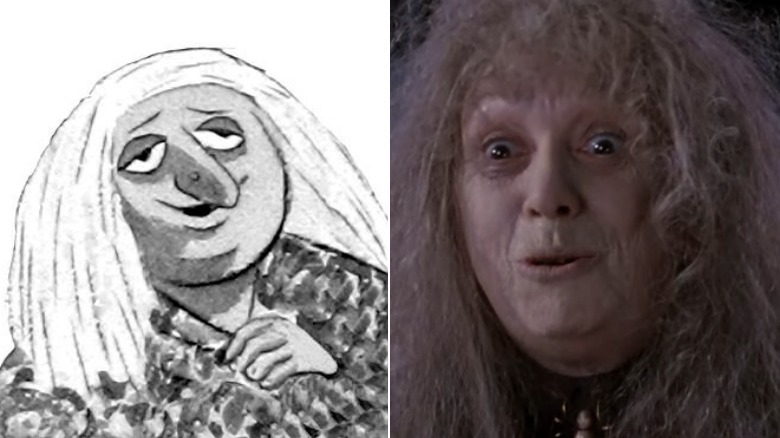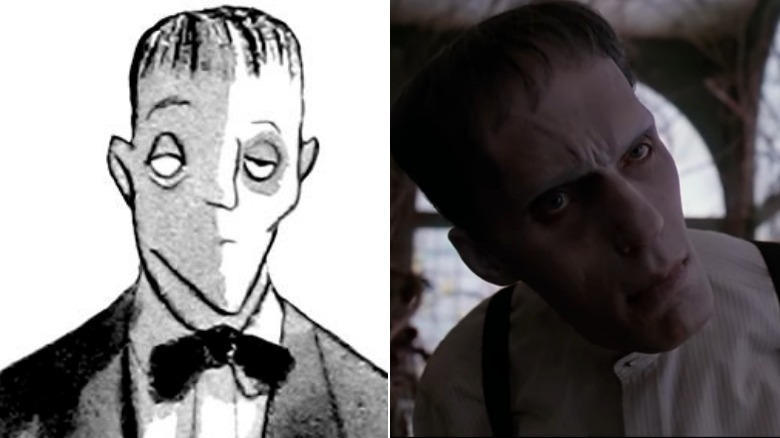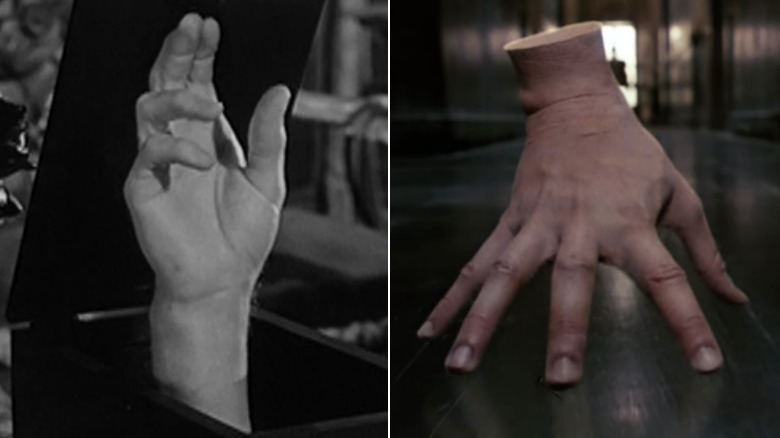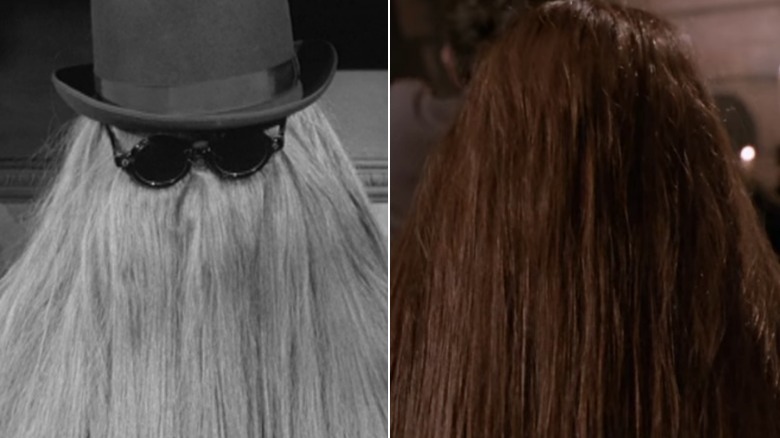What The Addams Family Cast Should Really Look Like
They're creepy and they're kooky, mysterious and spooky — in fact, for nearly 30 years they didn't have first names. Cartoonist Charles Addams drew the first "Addams Family" comic for a 1938 issue of The New Yorker. That first comic was a one-panel gag about a friendly vacuum cleaner salesman showing his wares to a sinister-looking woman dressed in black and a hulking, bearded man as bats fly around their cobweb-infested home. Throughout the 1940s and '50s, Addams would return to this strange, macabre family, refining them over nearly 60 comics into a familiar cast. These characters included the sleepy-eyed father, a slinky vampiric mother, a devilish little boy, a melancholic little girl, a witchy grandmother, and a corpse-like uncle. Still, it wasn't until ABC developed a live-action "The Addams Family" sitcom in 1964 that Addams actually gave names to his creations.
The television series, starring John Astin and Carolyn Jones as the newly-christened Gomez and Morticia Addams, lasted just two seasons but spent decades spent playing in syndication. This longevity — coupled with quite possibly the world's catchiest theme song — kept the altogether ooky clan in the public eye. In 1991, Paramount Pictures released a hit feature film adaptation starring Raul Julia as Gomez, Anjelica Huston as Morticia, and Christopher Lloyd as an impostor Uncle Fester.
Director Barry Sonnenfeld looked to Addams' original cartoons for inspiration, directly recreating famous gags like the Addams pouring hot oil on Christmas carolers in the film. Let's take a look at how Sonnenfeld's version of the Addams family compared to Addams' original designs.
Gomez
Raúl Juliá's Gomez resembles Addams' version of the character in a lot of ways. He is a cigar enthusiast, having started smoking at age five at his mother's insistence. He dresses in styles from bygone eras — most famously, he wears a thick striped double-breasted suit. He lives life with romantic gusto and a gleam of madness in his eye.
However, perhaps most importantly, Gomez cares for his family above all else and remains passionately in love with his wife, Morticia. The main joke of the Addams Family, from the original comics through the 2022 Netflix adaptation "Wednesday" is that the Addams, for all their scary habits, are more loving and supportive of each other than the average "normal" family.
Still, Juliá's Gomez differs from Addams' in one key way. Juliá was a handsome and glamorous star of stage and screen, and Addams' Gomez is, to put it gently, not. With his heavy-lidded eyes, upturned nose, bad haircut, and even worse teeth, the comic version of him is not the (acquitted) ladykiller so memorably portrayed in the 1991 film and the 1993 sequel "Addams Family Values." For many fans, though, Juliá's heartthrob Gomez is their preferred version, to the point that the more comic-faithful depictions by Luis Guzmán in "Wednesday" and the 2019 CGI film (voiced by Oscar Isaac) have drawn criticism from fans.
Morticia
Where Gomez's look has proven to be malleable over the years, there is but one aesthetic for his beloved wife Morticia. Even in that very first comic from 1938, Morticia's style and overall vibe were in place. There, she wears her iconic long black dress, form-fitting and low-cut with her jet-black hair parted down the middle framing dark, sultry eyes on a pale face.
In the 1964 series Carolyn Jones was practically the cartoon brought to life, and other than a bright pop of red on her lips, Anjelica Huston's take on the character is remarkably similar. "Wednesday" also knows not to mess with a good thing. Its Morticia, Catherine Zeta-Jones, looks no different from Huston or Jones. Why should she? It's an instantly recognizable look, spooky and seductive all at the same time. Perhaps not coincidentally, all three of Charles Addams' wives had a particularly "Morticia" look about them.
Like Gomez, the "joke" of Morticia is that she is not very much different from any other wife and mother. She keeps her children in line, makes sure Wednesday plays with her food, and prides herself on the home she's made. When she sees that Fester has packed a bottle of cyanide for his stay with the Addams, she smiles gently. "Fester..." she says, "as if we'd run out." Sonnenfeld shoots Huston's close-ups with a noir-ish shaft of light across her eyes, no matter what the rest of the scene looks like, and her potent chemistry with Juliá inspired a viral joke in 2020 that many fans took at face value.
Wednesday
The melancholic little sister Wednesday is almost as iconic in her look as her mother, with her prim black dress and long dark hair. In Addams' original conception, Wednesday often played sidekick to her more outwardly malevolent brother Pugsley. As played by Lisa Loring on the 1964 series, she was not terribly different from other sitcom moppets of the era, mostly on hand to cute and heartwarming and funny in her precociousness, as in the much-memed Season 2 scene when she teaches Lurch how to dance.
For the film, however, Sonnenfeld and his writers made a couple of smart tweaks to the character. They switched up the children's ages, making Wednesday the assertive older child and Pugsley her tag-along younger brother, and her relationship with the amnesiac Fester (who thinks he's a conman named Gordon pretending to be Fester) is surprisingly poignant. Still, the film's greatest asset was Christina Ricci in the role, a preternaturally withering young actor who, like Huston and Juliá, seemed to have an instinctive grasp of the film's tricky tone.
Wednesday (and Ricci) would come into her own as an icon of goth kids everywhere in the (literally) campy "Addams Family Values," and Jenna Ortega's take on the character in "Wednesday" (where Ricci appears in a supporting role) draws heavily from the films.
Pugsley
With his fair hair, stocky frame, and smiling face, Pugsley is the all-American boy — except for the fact that Pugsley's smile is usually seen after he is done cutting down road signs and throwing extra logs on the fire for Santa on Christmas Eve. In Addams' cartoons and the 1964 series (where he was played by Ken Weatherwax), Pugsley is the instigator, a malevolent sprite who builds toy guillotines and has a menagerie of strange and deadly pets. His talent with explosives is always getting him into one kind of trouble or another, but to Gomez and Morticia this was just good old-fashioned fun, a bit of mischief on the way to growing up.
The film Pugsley's famous striped shirt and some of his best-known habits — he still makes the roads around the Addams home dangerous by cutting down stop signs and the like — are carried over from earlier iterations of the character. However, Pugsley's overall role in the 1991 film is diminished in favor of Wednesday, who has a much more substantive part. As played by Jimmy Workman, Pugsley is a cheerful boy who seems happy just to be included in his sister's games, even when that game involves strapping him into an electric chair or shooting at him with crossbows.
Uncle Fester
Whose uncle is Fester, exactly? The chrome-domed family member, habitually clad in a dark overcoat with a thick collar, is often found puttering around the Addams home, reading books on toxicology for fun or (not) admiring himself in the mirror. In the 1964 series, Fester (played by former child star Jackie Coogan) lives with the Addams but is Morticia's uncle, making him a member of the Frump family. The series also introduced Fester's most famous skill — powering a lightbulb by sticking it in his mouth.
For the 1991 film, however, Fester is Gomez's brother instead of Morticia's uncle. In fact, he is not even Fester, at least not at first. As played by Christopher Lloyd (whose famously lanky frame is hidden under burly prosthetics and Fester's signature coat), he starts the film as Gordon Craven, a curly-haired enforcer for his con artist mother (Elizabeth Wilson) who bears an incredible resemblance to the long-lost Fester. Infiltrating the Addams home, Gordon pretends to be Fester to gain access to the famed Addams fortune, but as he spends more time with the family, he finds the loving home he'd never had before.
The film's original ending had the Addams accept Gordon as one of their own, but after a cast mutiny, the script was rewritten to reveal that Gordon really was Fester, who had lost his memory after a shipwreck in the Bermuda Triangle.
Granny
In another case of the Addams' malleable family tree, Granny (or Grandmama) started as an elderly member of the Addams clan. With a wild shock of white hair and a long witch's nose, she was someone's grandmother, though it was not clear exactly whose. For the 1964 series, she was established as Gomez's mother, Grandmama, and played by Marie Blake. Morticia's mother, Grandma Frump, was a separate, much sterner, character than Grandmama who appeared just a handful of times on the series, portrayed by the Wicked Witch of the West herself, Margaret Hamilton.
Judith Malina, the co-founder of the experimental troupe The Living Theatre, played Granny in the 1991 film as a hybrid of the two characters. She has all of the traits of Grandmama Addams, from her appearance to her eccentric cooking style to her facility with spells and seances, but here she is Morticia's mother, not Gomez's. Malina played Granny in the first film but did not return for "Addams Family Values." There, Carol Kane, under layers of old age makeup and prosthetics, stepped into the role.
The 2019 animated adaptation separated the grandmothers into separate characters once again, with Bette Midler voicing Grandmama (mother to Gomez and Fester) and Catherine O'Hara as Morticia's mother Granny Frump.
Lurch
Lurch, the hulking manservant with a suspicious resemblance to Boris Karloff as Frankenstein's monster, was a loyal, welcome presence for the Addams family in the original comics and has continued to faithfully serve the clan across its many iterations. Voice actor Ted Cassidy brought the very tall butler to life in the 1964 series and gave the traditionally mute character not only a selection of catchphrases ("You rang?" being the most well-known of them) but his novelty song and dance craze. Decades before MC Hammer told us how the Addams do what they wanna do and say what they wanna say, Lurch was teaching everyone how to do the Lurch dance.
Carel Struycken filled the role of the harpsichord-playing reanimated corpse for the 1991 film and its sequel. Struycken's version of the character was once again mute, save for a few grunts here and there, and his extended physique and flat-top hairstyle made him the spitting image of Addams' original cartoons. Struycken reprised the role for the 1998 direct-to-video adaptation "Addams Family Reunion" starring Tim Curry and Daryl Hannah as Gomez and Morticia.
Despite Struycken's presence, "Reunion" was not intended to be a direct sequel to Sonnenfeld's films but rather the feature-length pilot for a Canadian-produced series that ran for 65 episodes, "The New Addams Family."
Thing
Thing, the disembodied hand that serves as the family's gofer, assistant, and overall factotum, was not a part of Addams' original comics, other than a single gag that features a sign outside the Addams mansion reading "Beware of the Thing." Thing (or Thing T. Thing, his full name) as we know and love him was developed for the 1964 series and played by Lurch actor Ted Cassidy most of the time, although when Lurch and Thing had to be in a scene together, a member of the crew would lend a hand, so to speak. Thing would appear out from various boxes in every room of the mansion, usually just a hand and wrist, but every so often he would grow nearly an entire forearm if the situation required.
Visual effects had improved significantly by 1991, and Sonnenfeld's most lasting change to any of the characters is arguably freeing Thing from his box and letting him roam free, crawling on his fingertips like a five-legged spider. Actor and magician Christopher Hart played the helpful appendage through a combination of optical effects, animatronics, and good old-fashioned sticking your hand through a hole in the table.
Hart played the role in both Sonnenfeld films and "Addams Family Reunion," and every depiction of Thing in the years since has walked in his fingersteps. Once freed from the box, he would never go back.
Cousin Itt
Although a little hairy fellow with glasses sometimes appeared in Addams' comics, the character of Cousin Itt was a development of the 1964 series, premiering in the Season 1 episode "Cousin Itt Visits the Addams Family." Played by actor Felix Silla, Itt has visible arms and legs in his first appearance and his high-speed gibberish is at a somewhat lower pitch. By Season 2, though, he had been streamlined into a limbless bulb of straight, shiny hair, sometimes accompanied by a jaunty hat and pair of sunglasses, and his nonsense language (which the Addams can, of course, understand perfectly) had pitched up into chipmunk register.
Sonnenfeld could not improve upon perfection, so the 1991 version of Itt (played by John Franklin) looks and sounds essentially the same as he did on television. From his first appearance, Itt was a wandering soul, a jack of all trades, and also a bit of a cad. In the film he is no better, seducing the wife (Dana Ivey) of Gomez's duplicitous lawyer Tully (Dan Hedaya) and eventually marrying her after Tully dies. By "Addams Family Values" the happy couple have a little hairy bundle of joy named What.
